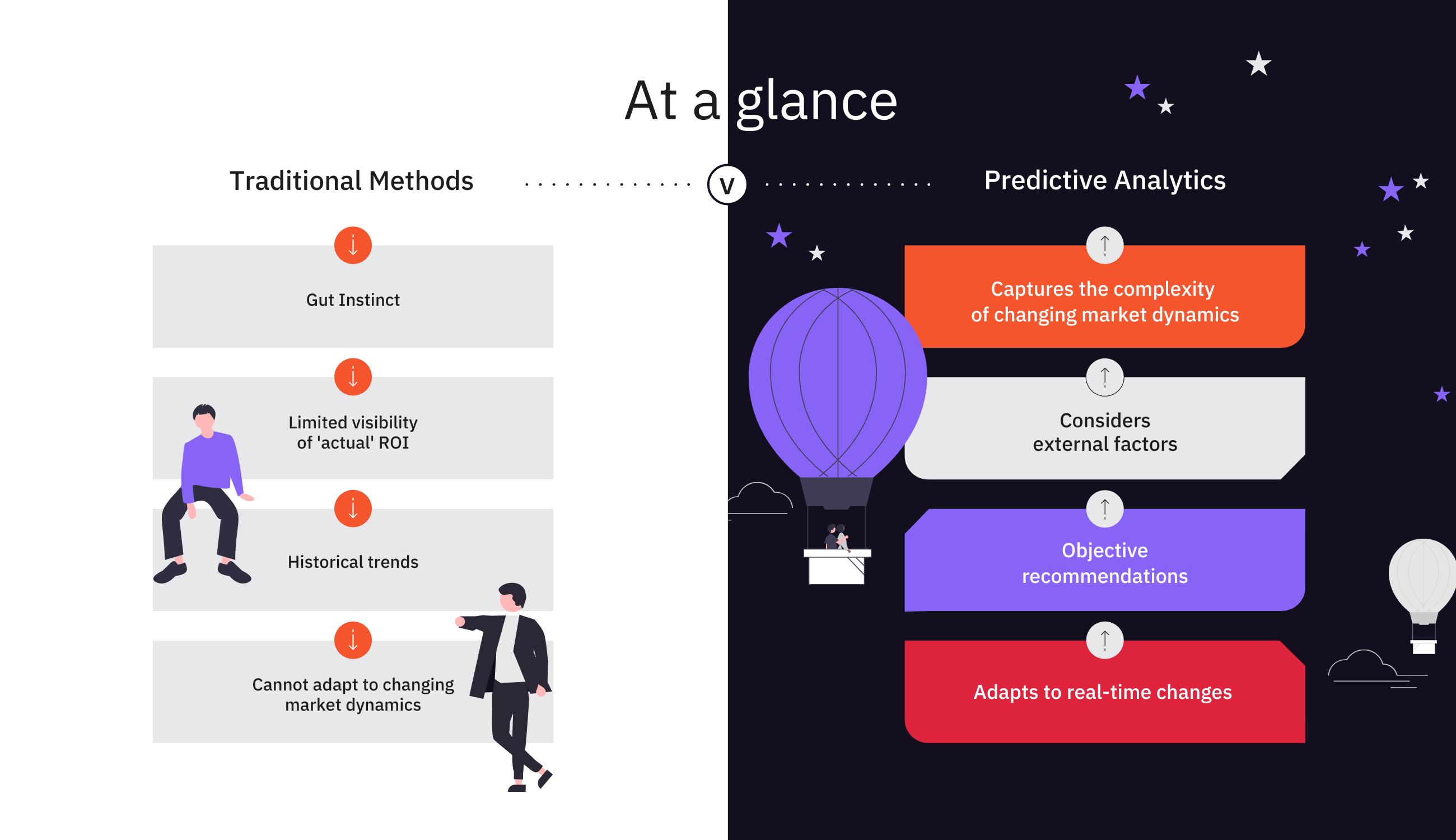Introduction
In today’s dynamic and data-driven business landscape, traditional approaches to marketing spend allocation are proving to be inadequate. Manual decision-making processes, once the norm, are plagued by limitations that hinder the effectiveness and efficiency of marketing
campaigns. However, there is a powerful solution on the horizon: predictive analytics. By harnessing the potential of predictive analytics, businesses can overcome the problems associated with traditional marketing spend allocation and unlock new opportunities for growth and success.
In this blog we will examine some of the key issues Marketing teams face today with using traditional methods, and the way that predictive analytics can remove the reliance on them.

Problem 1: Subjectivity and Biases in Decision-Making
One of the key issues with traditional approaches to marketing spend allocation is the heavy reliance on human judgment and intuition. Marketing professionals often make decisions based on personal experiences or assumptions, leading to subjective and biased choices. This can result in suboptimal resource allocation, wasted marketing budgets, and missed opportunities to reach the right audience. However, predictive analytics offers an objective and data-driven alternative.
Solution: Data-Driven Decision-Making
Predictive analytics empowers marketers to make decisions based on concrete data and insights rather than subjective opinions. By leveraging advanced algorithms and machine learning techniques, businesses can analyse vast amounts of customer and market data to
identify valuable patterns, trends, and insights. This data-driven approach ensures that marketing spend is allocated strategically, targeting the right audience with the right message at the right time.
Problem 2: Inability to Respond Quickly to Market Dynamics
Traditional decision-making processes often lack scalability and agility, making it challenging for businesses to respond quickly to changing market conditions such as recessions or economic growth, or customer preferences like sustainability, or cultural trends. By the time decisions are made, the window of opportunity for effective marketing campaigns may have passed, reducing their impact and relevance.
Solution: Real-Time Insights and Rapid Adaptation
Predictive analytics enables businesses to gather and analyse data in real-time, providing up-to-date insights into market dynamics and customer behaviour. By continuously monitoring and analysing data, businesses can swiftly adapt their marketing strategies, allocating spend
where it will yield the best results. This agility ensures that marketing efforts remain relevant, impactful, and aligned with ever-changing market trends.
Problem 3: Inefficient Resource Utilisation
Manual decision-making processes often struggle to effectively analyse and process vast amounts of data. Retailers generate an immense volume of customer and market data, including purchase history, demographic information, online behaviour, and social media interactions. Manually analysing this data becomes impractical and time-consuming, limiting the ability to identify valuable opportunities for targeted marketing and customer segmentation.
Solution: Algorithm Generated Customer Insights
Predictive analytics discovers valuable and useful patterns, trends, and insights from large amounts of data. It’s like searching for hidden treasures within a vast collection of information. By identifying patterns and correlations within customer behaviour, businesses can gain a deep
understanding of their target audience. This enables more precise segmentation, personalised campaigns, optimised ad spend and tailored marketing strategies, ultimately leading to higher conversion rates and customer satisfaction.
Problem 4: Lack of External Data Sources
Traditional approaches to marketing spend allocation often rely solely on internal data sources, limiting the breadth and depth of insights available. Without access to external data, businesses miss out on valuable information that can provide a more comprehensive understanding of the market landscape, competitors, and emerging trends. This lack of external data sources restricts the ability to make informed decisions and allocate marketing spend effectively.
Solution: Integration of External Data and Third-Party Sources
Predictive analytics enables businesses to integrate external data and leverage third-party sources to augment their decision-making process. By incorporating data from social media platforms, industry reports, customer reviews, and other relevant sources, businesses can gain a holistic view of the market. This enriched data ecosystem empowers marketers to make more informed decisions, identify untapped opportunities, and allocate marketing spend based on a broader and more accurate understanding of the market dynamics.
Problem 5: Inaccurate Predictions and Forecasting
Accurate forecasting and prediction are essential for effective marketing spend allocation. However, traditional approaches relying solely on manual processes often fall short in this regard. Predicting customer behaviour and market trends is challenging without leveraging historical data, relevant external data sources, and advanced statistical models.
Solution: Advanced Statistical Modelling and Predictive Algorithms
Predictive analytics empowers businesses to forecast and predict customer behaviour and market trends with a higher degree of accuracy. By analysing historical data, predictive models can identify patterns, detect emerging trends, and make reliable predictions. These insights enable businesses to allocate marketing spend proactively, optimise inventory management, and seize revenue opportunities.
Conclusion:
Traditional approaches to marketing spend allocation are riddled with limitations that can hinder business growth and success. However, by embracing predictive analytics, Organisations can revolutionise their decision-making processes. The power of data-driven insights, real-time adaptation, efficient resource utilisation, and accurate forecasting can unlock new opportunities, drive targeted marketing efforts, optimise return on investment, and enhance overall marketing effectiveness.
